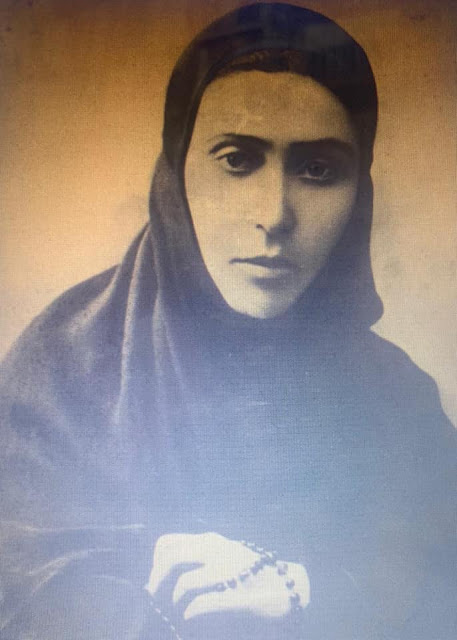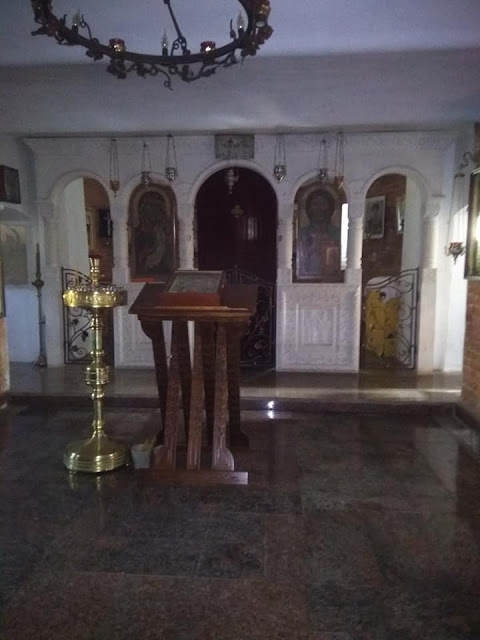 |
Tamara Marjanova was born in a Georgian princely family, lost her father early and her mother at the age of 19. She remained independent in her family estate with her younger sister. With her voice and musical abilities, she was preparing to enter the St. Petersburg Conservatory.
One day her aunt invited her nieces to visit her, offering to see the newly opened Russian convent of St Nina. The sisters came to Signy and went to the Bodbe Monastery for the all-night vigil. When Tamara entered the church, she thought: "I will enter the monastery". The hegumena Juvenalia noticed them and asked why they were in mourning. They said, "Our mother died." Tamara returned to her aunt with the intention of entering the monastery. Soon she met with the hegumena, told her about her desire and that she could not contribute to the monastery until she was old enough. The hegumena replied that admission was possible without a contribution.
At home, Tamara began to prepare to leave, but her family hindered her and intercepted her mail. The hegumena Juvenalia sent a novice to find out the reason for Tamara's delay, and with the help of her relatives she organized Tamara's secret escape to the monastery.
Mother Juvenalia replaced her birth mother and became her spiritual mother, placed her in her cell, taught reading, church singing and all the rules of monastic life.
Before long the abbess noticed that Tamara began to return late to the cell, and found out that she and other novices had begun to dig caves in the neighboring mountains, to save themselves within them. The wise directress forbade them to continue this dangerous podvig.
For fouteen years, Tamara lived in the monastery and at the age of 28 she was tonsured a nun with the name Juvenalia.
In 1902, the Bodbe hegumena was transferred to Moscow to be the abbess of the Nativity Monastery, and the young mother Juvenlia was appointed superior of Bodbe. On October 12, 1902, Archbishop Alexis, Patriarch of Georgia, elevated Yuven to hegumenia. The Lord helped his chosen one, and the new hegumen began to rule the monastery with honor. These were the most difficult years for Georgia and the Georgian Church in the Russian Empire. Worship in the Georgian language was forbidden. During this difficult period, with the efforts of hegumena Juvenalia, the teaching of the Georgian language at the Bodbe Women's School became mandatory from the first to the final grade. Thanks to her, liturgy and chanting were held in Georgian at the Bodbe Monastery. The hegumena constantly took care of the material condition of Georgian teachers and students and systematically requested financial assistance from the Georgian Exarchate or the Russian Synod. Her perseverance and self-sacrifice were achieved only after the greatest effort.
Father Juvenaly had a significant influence on his mother. Father John of Kronstadt, with whom she repeatedly met, coming to St. Petersburg and Moscow on business. One day at the beginning of the service at the old hegumen's monastery ran out of money, suddenly they received 200 rubles, and then a letter from Father John: “Receive, my dears, in your extreme need two hundred rubles.” It was amazing because none of them knew Fr. John. At one encounter with Fr. John, before Tamara was tonsured, he demanded the cross from Abbess Juvenalia and put it on Tamara, jokingly saying: “You are my abbess.”
On October 12, 1902, the Georgian exarch Archbishop Alexei elevated Juvenalia to the rank of abbess. The Lord helped His chosen one, and the new abbess began to manage the monastery honorably.
Mother Juvenalia was significantly influenced by Fr. John of Kronstadt, who she met on several occasions while attending business in St. Petersburg and Moscow.
Once, in the beginning of her service under the old abbess, all the money dried up in the monastery. Unexpectedly they received two hundred rubles and then a letter from Fr. John: “Receive, my dears, in your extreme need two hundred rubles.” It was amazing because none of them knew Fr. John. At one encounter with Fr. John, before Tamara was tonsured, he demanded the cross from Abbess Juvenalia and put it on Tamara, jokingly saying: “You are my abbess.”
When the young abbess met and spoke with Fr. John after her appointment she felt that he “took away her grief, and infused her with energy and joy.”
St. Seraphim of Sarov gave her great help, support and protection. In her youth she saw a dream in which Fr. Seraphim asked her blessing, saying, “Mother abbess, bless,” thus predicting her abbacy, fourteen years in advance.
On July 19, 1903 Fr. Seraphim’s relics were opened, and Mother sent Nun Agnes to pray for the whole monastery, bearing an icon of the God-bearer Seraphim. Once an inhabitant of the monastery was injured while stacking firewood and was on the brink of death. Mother sent her the icon of St. Seraphim to be placed on the chest of the sufferer. Half an hour later the nun jumped out of bed, fully healthy. She saw the blessed elder coming towards her and saying: “Let’s go, wash yourself in my spring, and you’ll be healthy.” She threw herself at the elder’s feet on her knees, began to pray to him, and immediately revived and began to speak. The doctor confirmed that it was a full recovery.
In the pre-revolutionary years a spiritual circle of those close to her developed. Among them was the Grand Duchess Elizabeth Fedorovna, who received her at the Martha and Mary Convent; Sts. Gabriel of Seven Lakes Hermitage; Fr. Alexei of the St. Zosima Hermitage; and Bishop Arseny (Zhadanovskii).
The Lord preserved her and in the years of the first Russian revolution. When some mountaineers were irritated by her (Mother had given shelter in the monastery to peasants suffering from their harassment), and they literally shot her carriage full of holes. At that moment, when the shooting began, the abbess prayerfully raised above herself, accompanied by her sisters, the icon of St. Seraphim of Sarov, who she greatly venerated, and although her horse fell under a hailstorm of bullets, the driver was killed, and the halted carriage became a target, the nuns were not injured. After this episode, in 1905, she was transferred to Moscow against her will by Synodal decree, and appointed the superior of the Pokrov community of Sisters of Mercy, where there were twenty nuns and 210 Sisters of Mercy.
By the time of Mother Juvenalia’s departure in 1907 from Bodbe Monastery there were 180 sisters and two working schools: one beyond the walls of the monastery for children who would come daily, and the second for 120 girls living entirely on the monastery’s provisions and receiving the rank of teachers of the lower classes. Russians, Georgians, Ossetians, Greeks, Svanis, and Armenians all lived together. The Bodbe Convent began in 1889 with the arrival of six nuns with Mother Juvenalia. It was opened at the behest of Emperor Alexander III, who traveled there to venerate the tomb of the Equal-to-the-Apostles, holy virgin and enlightener Nina.
After her miraculous survival, the holy ascetic St. Seraphim became for Mother a truly living, real person. Venerable Seraphim helped her in troubling circumstances, protecting her from dangers.
During a pilgrimage to Sarov in 1908, Mother stopped at the Royal Hermitage and walked eight miles on her ailing feet to Sarov, where she fervently implored the saint to stay near her. Returning and communing the next day, she prayed before the icon of the Mother of God of the Sign, and from the Heavenly Kingdom she heard a voice: “No, you will not stay here, but will build a skete not only for yourself, but for others as well.” And every day when she went up to the icon she heard the same voice.
Thinking it was a temptation, she upon her return asked advice from Fr. Alexei, the hermit of the Zosima Hermitage, who blessed her to build the skete herself somewhere in the forest: “You will retreat to there, and then finally move. The Queen of Heaven has chosen you and the place, and will provide the means and spiritually arrange everything.”
Before long she had to leave to inspect a farm in the woods near the Vostryakovo Station and the village of Bityagovo, which belonged to the community, and to register its transfer to the railway, which wanted to extract sand from there; but she understood that that was the place where she had to build the skete. According to the advice of Fr. Alexei, she began to push for saving this place for the community.
To determine how to conduct herself, Matushka went to Optina Pustyn, and all the elders with whom she spoke directed her on how to arrange the skete. To completely check herself, she traveled to the Trinity-St. Sergius Lavra to pray to St. Sergius. The Father Superior of the Lavra, Fr. Tobias, listened to her, went to his office, and returned with an icon in his hands, saying: “Well, Mother, let’s pray and I will bless you. You should arrange the skete yourself—it is the will of the Heavenly Queen.” With these words he inspired her to determination and confidence.
Having besought the blessing of Venerable Sergius, Matushka began to arrange the skete. A. V. Schusev, who had designed many churches, including the Martha and Mary Convent, participated in the first stage of designing the skete.
The foundation was completed in the summer of 1910, and from henceforth the project was carried out by architect L. V. Sterzhenskii. The complex has a square plan, with a tiered church in the center, and twelve cells symmetrically placed around the perimeter of the brick walls. Thirty-three sisters lived in the skete—the number of years of Christ’s earthly life.
On September 29, 1912, Metropolitan Vladimir (Bogoyavlenskii) of Moscow and Kolomna consecrated the Seraphimo-Znamenskii Skete. In 1915, Abbess Juvenalia was tonsured into the schema with the name Fomar. With great spiritual enthusiasm, and a feeling of unconquerable faith and love for the Lord, she stretched herself on the earth in the sign of the crucifix for the sake of higher spiritual goals.
Mother Fomar established a strict order in the skete. The thirty-three sisters occupied themselves only with prayerful service, not participating in the monastery administration. The administrative offices were in a house beyond the walls of the skete. The sisters were spiritually guided by the skete’s elder, Bishop Arseny (Zhadanovskii), who stayed in a separate cabin with Archimandrite Seraphim (Zvdezdinsky), traveling weekly to the skete. They called the cabin the cenobium, and would seclude themselves there for prayer.
The St. Seraphim- Znamenskii Skete (Of the Sign) existed for twelve years. It was closed and destroyed by the Bolsheviks in 1924. The sisters dispersed in various directions. Mother relocated with ten sisters and Hieromonk Philaret (Postnikov) to Perkhushkovo. Many went to Mother Fomar for advice and guidance.
In 1931 Mother Fomar, the priest, and some sisters were arrested and then exiled to Siberia, 130 miles from Irkutsk. In 1934 Mother Fomar, having contracted a serious lung disease, was returned from exile and placed in a suburban village by Pioneer Station on the Belorusian Railway. She showed signs of tuberculosis. Mother reposed on June 23, 1936, and Vladyka Arseny celebrated her funeral service at home, burying her at the Entrance of the Mother of God cemetery in Moscow. Every year on the Sunday of the Holy Myrrhbearers, on her name’s day, and on the day of her repose, June 23, those who venerate her arrive for Pannikhidas served there.
 |
Seraphim-Znamanski skete where her relics are kept







No comments:
Post a Comment
Note: Only a member of this blog may post a comment.